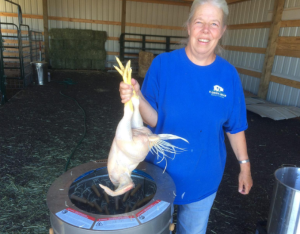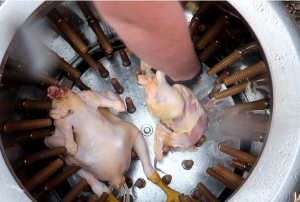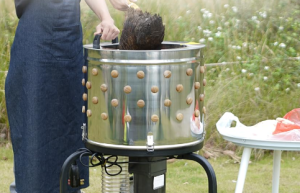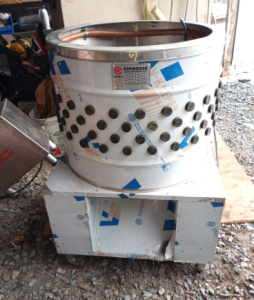Best Chicken Auto Defeathering Machines
If you’re looking to streamline your poultry processing, investing in an automatic chicken defeathering machine is a must. These machines save time, reduce labor, and ensure a thorough job. Here’s a detailed guide to help you choose the best auto defeathering machine for your needs.
Why Choose an Automatic Chicken Defeathering Machine?
- Efficiency: Defeather multiple birds in minutes.
- Consistency: Ensures even plucking without damaging the skin.
- Ease of Use: Simple operation requiring minimal effort.
- Hygiene: Maintains sanitary conditions by reducing hand contact.
Top Automatic Chicken Defeathering Machines
Here are some of the best automatic chicken defeathering machines available on Amazon:
1. Yardbird 21833 Chicken Plucker

- Capacity: Can handle 2-3 chickens at a time.
- Power: 1.5 HP motor.
- Material: Stainless steel tub and housing.
- Special Features: Integrated irrigation ring, easy to move with built-in wheels.
- Price: $$
2. Kitchener Chicken Plucker

- Capacity: Suitable for up to 4 chickens.
- Power: 1.2 HP motor.
- Material: Food-grade stainless steel.
- Special Features: Feather discharge chute for easy cleanup, waterproof on/off switch.
- Price: $$
3. PowerPlucker Pro

- Capacity: Efficient for small batches, 2-3 chickens.
- Power: 1 HP motor.
- Material: Aluminum alloy.
- Special Features: Compact design, easy to assemble and disassemble for cleaning.
- Price: $
4. EZPlucker EZ-151

- Capacity: Can process 1-2 chickens.
- Power: 1.5 HP motor.
- Material: Stainless steel.
- Special Features: Portable design, suitable for quail, pigeons, and other small birds.
- Price: $$
Step-by-Step Guide to Using an Automatic Chicken Defeathering Machine
1. Preparation
Gather the necessary tools and equipment:
- Sharp Knife: For killing and cleaning the chicken.
- Large Pot: For scalding water.
- Thermometer: To check water temperature.
- Gloves: For handling the chicken and hot water.
- Bucket: To catch blood and feathers.
- Chicken Defeathering Machine: For efficient plucking.
2. Killing the Chicken
- Choose a Method: Use a humane method, such as a killing cone or a sharp knife to quickly cut the jugular vein. Ensure the chicken is calm to minimize stress.
- Bleed Out: Allow the chicken to bleed out completely by hanging it upside down for a few minutes to ensure the meat stays fresh longer.
3. Scalding
- Heat Water: Fill a large pot with water and heat it to 145-150°F (63-66°C). Use a thermometer to maintain the correct temperature.
- Scald the Chicken: Hold the chicken by its feet and immerse it in the hot water for about 30-60 seconds. Move it around to ensure even scalding. The feathers should come out easily when the scalding is complete.
4. Plucking Feathers
Using the Defeathering Machine
- Prepare the Machine: Set up your defeathering machine according to the manufacturer’s instructions.
- Load the Machine: Place the scalded chicken into the machine. Ensure not to overcrowd it; most machines can handle 1-4 chickens at a time.
- Start the Machine: Turn on the machine and let it run for about 30-60 seconds. The rubber fingers will remove the feathers.
- Inspect the Chicken: Once the machine stops, check the chicken for any remaining feathers and remove them manually if needed.
Post-Defeathering Cleanup
- Evisceration: Make a small incision near the vent and carefully remove the internal organs. Be cautious not to puncture any organs to avoid contamination.
- Clean the Chicken: Rinse the chicken thoroughly inside and out with cold water.
- Store or Cook: The chicken is now ready for cooking or can be stored in a refrigerator or freezer.
Tips for Efficient Defeathering
- Proper Scalding: The key to easy feather removal is proper scalding. If the water is too hot, it can cook the skin; if it’s too cool, the feathers won’t loosen properly.
- Use Gloves: Handling hot water and feathers can be tough on your hands, so wear gloves for protection.
- Check Temperature: Keep the water temperature consistent throughout the scalding process.
- Clean Workspace: Maintain a clean and organized workspace to prevent contamination and ensure hygiene.
Common Issues and Solutions
- Feathers Not Coming Off Easily: This usually means the scalding water wasn’t hot enough or the chicken wasn’t immersed long enough. Adjust the water temperature and duration accordingly.
- Skin Tearing: This can occur if the water is too hot or the chicken is left in the defeathering machine too long. Maintain proper scalding temperature and monitor the machine closely.
- Remaining Pinfeathers: These can be stubborn. Use tweezers or a small knife to carefully remove them after the main feathers are plucked.
Conclusion
Defeathering a chicken is a straightforward process with the right tools and techniques. Using an automatic chicken defeathering machine from Amazon can significantly ease the process, making it faster and more efficient. Follow these steps, and you’ll have a clean, ready-to-cook chicken in no time. Happy processing!


